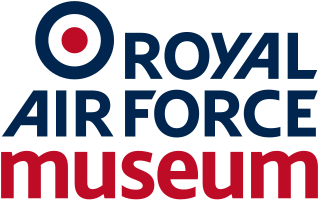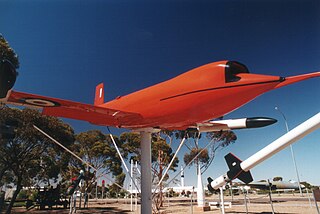
The Hawker Siddeley Harrier is a British jet-powered attack aircraft designed and produced by the British aerospace company Hawker Siddeley. It was the first operational ground attack and reconnaissance aircraft with vertical/short takeoff and landing (V/STOL) capabilities and the only truly successful V/STOL design of that era.

The Hawker Hunter is a transonic British jet-powered fighter aircraft that was developed by Hawker Aircraft for the Royal Air Force (RAF) during the late 1940s and early 1950s. It was designed to take advantage of the newly developed Rolls-Royce Avon turbojet engine and the swept wing, and was the first jet-powered aircraft produced by Hawker to be procured by the RAF. On 7 September 1953, the modified first prototype broke the world air speed record for aircraft, achieving a speed of 727.63 mph.

Aberdeen International Airport is an international airport, located in the Dyce suburb of Aberdeen, Scotland, approximately 5 nautical miles northwest of Aberdeen city centre. As of 2023, 1.9 million people used the airport.

Royal Air Force Kinloss, or more simply RAF Kinloss, is a former Royal Air Force station located near the village of Kinloss, on the Moray Firth in the north east of Scotland, UK.

The Royal Air Force Museum London is located on the former Hendon Aerodrome, in North London's Borough of Barnet. It includes five buildings and hangars showing the history of aviation and the Royal Air Force. It is part of the Royal Air Force Museum.

The Bristol Type 171 Sycamore is an early helicopter developed and built by the helicopter division of the Bristol Aeroplane Company. The name refers to the seeds of the sycamore tree, Acer pseudoplatanus, which fall with a rotating motion. It has the distinction of being the first British helicopter to receive a certificate of airworthiness, as well as being the first British-designed helicopter to be introduced by and to serve with the Royal Air Force (RAF).

Holbeach Air Weapons Range is a United Kingdom Ministry of Defence academic air weapons range (AWR) situated between Boston and King's Lynn in the civil parish of Gedney on The Wash, in Lincolnshire, eastern England.

RAF Andover is a former Royal Flying Corps and Royal Air Force station in England, 2 miles (3.2 km) west of Andover, Hampshire. As well as RFC and RAF units, units of the Aviation Section, U.S. Signal Corps, Royal Canadian Air Force, United States Army Air Forces, and the Air Transport Auxiliary were also stationed at the airfield.

Newark Air Museum is an air museum located on a former Royal Air Force station at Winthorpe, near Newark-on-Trent in Nottinghamshire, England. The museum contains a variety of aircraft.

Hawarden Airport, is an airport near Hawarden in Flintshire, Wales, near the border with England and 3.5 NM west southwest of the English city of Chester.

North Weald Airfield is an operational general aviation aerodrome, in the civil parish of North Weald Bassett in Epping Forest, Essex, England. It was an important fighter station during the Battle of Britain, when it was known as the RAF Station RAF North Weald. It is the home of North Weald Airfield Museum. It is home to many private aircraft and historic types, Essex & Herts Air Ambulance helicopter and is an active flight training airfield.

Royal Air Force Martlesham Heath or more simply RAF Martlesham Heath is a former Royal Air Force station located 1.5 miles (2.4 km) southwest of Woodbridge, Suffolk, England. It was active between 1917 and 1963, and played an important role in the development of Airborne Interception radar.

Caernarfon Airport, is a general aviation airport located 4 nautical miles southwest of Caernarfon, Gwynedd, Wales. It is on the site of the former RAF Llandwrog which was operational between 1941 and 1946. From the end of the 1960s, civil light aircraft started to use the aerodrome in greater numbers and eventually gained a full operating licence in 1976.

Redhill Aerodrome is an operational general aviation aerodrome located 1.5 NM south-east of Redhill, Surrey, England, in green belt land.

The GAF Jindivik is a radio-controlled target drone produced by the Australian Government Aircraft Factories (GAF). The name is from an Aboriginal Australian word meaning "the hunted one". Two manually-controlled prototypes, were built as the GAF Pika as a proof of concept to test the aerodynamics, engine and radio control systems, serialled A92-1/2, 'B-1/2'. The radio-controlled Jindivik was initially designated the Project B and received serials in the A93 series. Pika is an Aboriginal Australian word meaning flier.

The United Kingdom's Aeronautical Rescue Coordination Centre (ARCC) is based at the National Maritime Operations Centre (NMOC), Fareham, Hampshire.

Royal Air Force Llandwrog, or more simply RAF Llandwrog, is a former Royal Air Force station located near the village and in the community of Llandwrog, situated 3.5 miles (6 km) southwest of Caernarfon, Gwynedd, Wales.

Dunsfold Aerodrome is an unlicensed airfield in Surrey, England, near the village of Cranleigh. It extends across land in the villages of Dunsfold and Alfold.

No. 351 Squadron RAF was a Yugoslav Partisan-manned fighter-bomber squadron of the Royal Air Force (RAF) which was operational between 13 October 1944 and 1 May 1945 during World War II. The squadron was also known by the Partisans as Second Squadron (NOVJ).
The South Yorkshire Aircraft Museum (SYAM) is a Volunteer led museum located at Lakeside in Doncaster, South Yorkshire, England. It occupies the former site of the Royal Air Force Station, RAF Doncaster. The museum occupies the last remaining original buildings from RAF Doncaster in the shape of a Bellman hangar, two wooden Air Ministry 'Billet Huts' (Buildings 19 and 21) and various smaller structures. The museum has also erected an more modern ex Air Training Corps Cadet Hut alongside Building 21 to house its World War Two Collection.




















